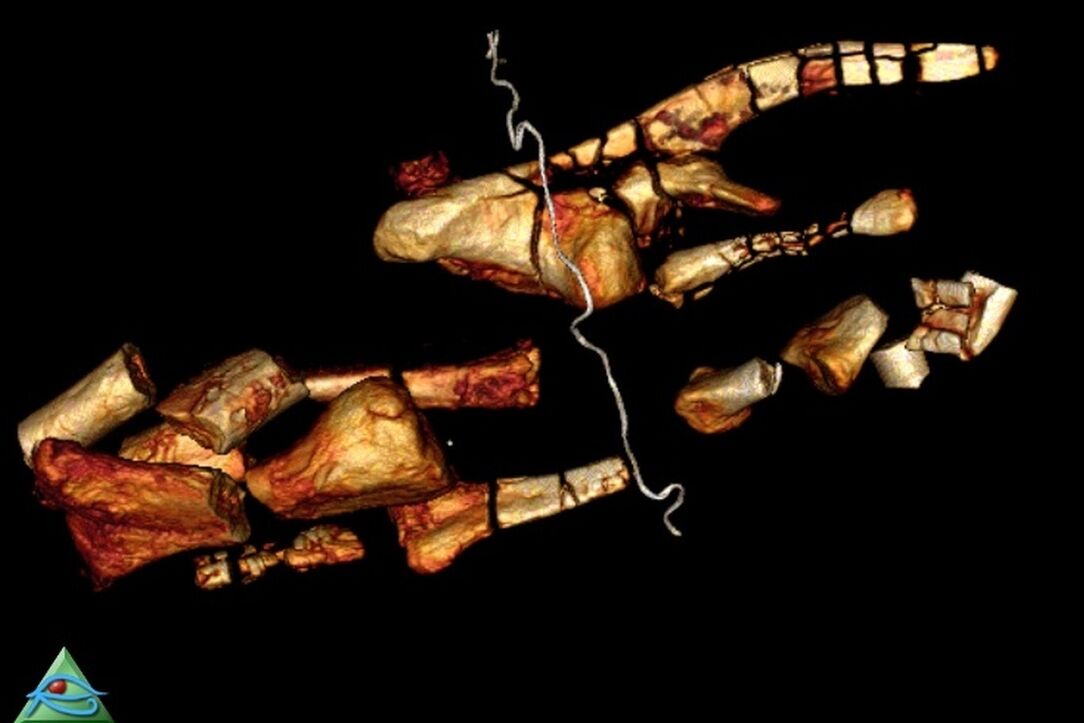With the help of computer tomography images, Berlin scientists from the Museum für Naturkunde (MfN), the Leibniz Institute for Zoo and Wildlife Research (Leibniz-IZW) and the Charité - university medicine of Berlin - reconstructed the contents of unopened expedition crates from the Tendaguru dinosaur site in Tanzania.

Virtual reconstruction of a bamboo corset with loose dinosaur bones and fossil-filled tin cans | Foto: Leibniz-IZW, MfN, Charite
The virtual preparation of the material in the bamboo corsets and transport crates revealed numerous dinosaur bones, mainly from the small gazelle dinosaur Dysalotosaurus lettowvorbecki, packed in hut clay lumps, in old tin cans or as whole collections of loose bones. With the help of these images, the team created a prioritisation list for the palaeontological preparation of this material. The images also provide a valuable testimony of this historic expedition and the performance of the Tanzanian excavation workers and porters in the colonial context.
Between 1909 and 1913, the Museum für Naturkunde Berlin organised and financed the German Tendaguru Expedition (DTE) to southern Tanzania, at that time the German colony Deutsch-Ostafrika. With the participation of more than 500 Tanzanian excavation workers, a large number of porters and two Berlin scientists, more than 230 tons of dinosaur material was brought to Berlin. The dinosaur material from Tendaguru turned out to be so rich and spectacular that the site is still considered to be one of the most important dinosaur localities worldwide. Of the dinosaur material from Tendaguru, 40 originally packed and unopened bamboo corsets and six wooden crates with unprepared bones - without precise documentation of their contents - are still in the vertebrate collection of the Museum für Naturkunde (MfN) in Berlin.
Preparing the material has not been possible until now, because of logistical reasons and time constraints, nor should the material, which comes from a single excavation site, be torn apart. "Until now, there was much uncertainty about how to handle this material, because the physical preparation really takes a lot of time and you also don't want to destroy historical documents from this era", explains Daniela Schwarz, head of the investigation team at the MfN. In order to analyse the contents of the transport containers without opening and potentially destroying them, colleagues from Leibniz-IZW and Charité helped with their high-quality (veterinary) medical computertomographs (CT). These are actually designed for human patients and at the Leibniz-IZW are used for the examination of wild, zoo and domestic animals. In addition to high-resolution cross-sectional images of bodies, serial images can also be combined into vivid 3D models.
This modern equipment can also penetrate rock, so a reconstruction of the crate contents of the Tendaguru expedition became possible. "We knew the expected dinosaur species from this site and the packing methods of the GTE have already been described, but it was still very exciting for all of us to finally know exactly what was in the remaining bamboo corsets without having to open them all right away," says Schwarz. The CT images revealed many individual bones from the gazelle dinosaur Dysalotosaurus lettowvorbecki, plus some bones of Kentrosaurus and sauropods.
In addition, this method allowed for an accurate documentation of already familiar excavation techniques: embedding bones in clay, collecting these many small vertebral bones, collecting small bones in tin cans in the field and carrying whole pieces of rock in specially made bamboo corsets stuffed with savanna grass. All of this work was done by local workers employed during the GTE, and the filled corsets were then carried to the coast during several days of foot marches by columns of porters.
"Two aspects were particularly important to me in the exploration of this material", explains Schwarz. "On the one hand, we wanted to make the fossil material from Tendaguru accessible to everyone in the future by way of digital images. On the other hand, it was important to define priorities for the preparation and decide which parts should be preserved in its original state as a valuable testimony of this historic expedition in the colonial context." The results show that it is possible to combine both purposes. The CT images are now available for download in the publication (https://doi.org/10.7479/d1pq-2g96), and a prioritization list for the paleontological preparation of this material was established.
Schwarz, Daniela, Fritsch, Guido, Issever, Ahi- Sema, and Hildebrandt, Thomas. 2023.
Description of contents of unopened bamboo corsets and crates from Quarry Ig/WJ of the Tendaguru locality (Late Jurassic, Tanzania, East Africa) as revealed by medical CT data and the potential of this data under paleontological and historical aspects. Palaeontologia Electronica, 26(1):a3.
palaeo-electronica.org/content/2023/3747-bamboo-corsets-from-tendaguru






